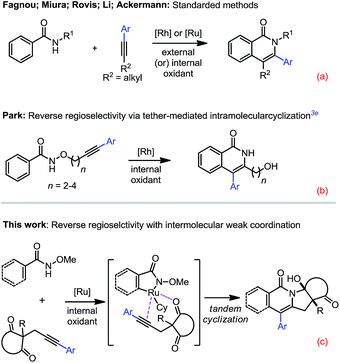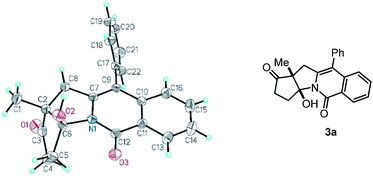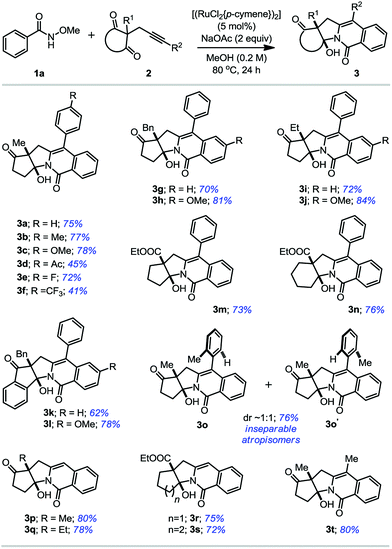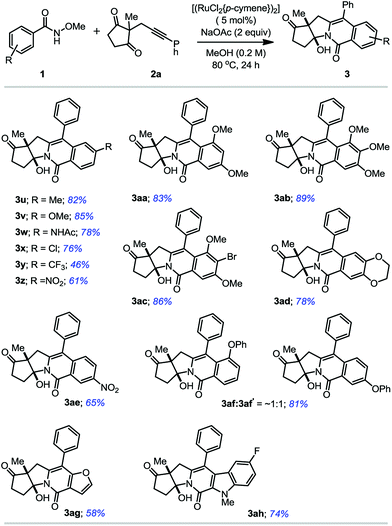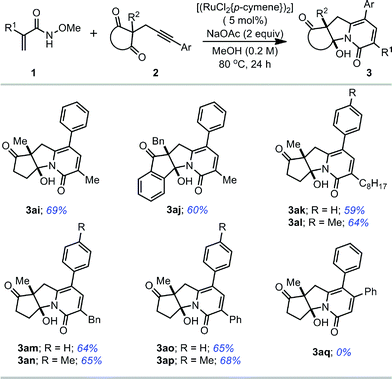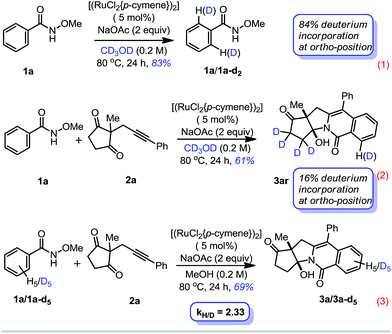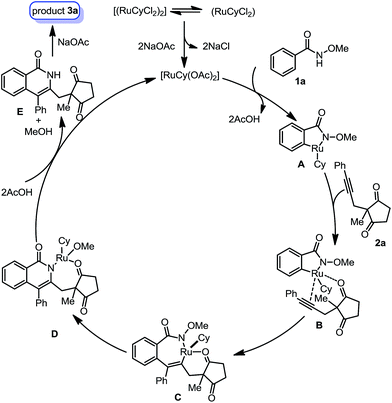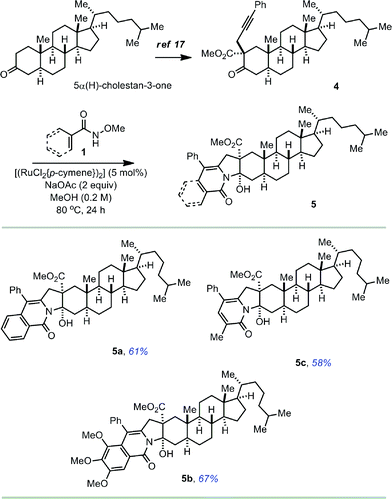 Open Access Article
Open Access ArticleCarbonyl-assisted reverse regioselective cascade annulation of 2-acetylenic ketones triggered by Ru-catalyzed C–H activation†
Krishna Kumar
Gollapelli‡
a,
Shivakrishna
Kallepu‡
a,
Nagendra
Govindappa
a,
Jagadeesh Babu
Nanubolu
b and
Rambabu
Chegondi
*a
aDivision of Natural Product Chemistry, CSIR-Indian Institute of Chemical Technology, Hyderabad 500007, India. E-mail: rchegondi@iict.res.in
bCentre for X-ray Crystallography, CSIR-Indian Institute of Chemical Technology, Hyderabad 500007, India
First published on 12th April 2016
Abstract
The first reverse regioselective intermolecular annulation of aryl substituted 2-acetylenic ketones with O-substituted N-hydroxybenzamides or acrylamides followed by tandem cyclization via ruthenium-catalyzed C–H activation, is reported. Excellent reverse selectivity of alkyne insertion was induced by the weak coordination between the carbonyl group and ruthenium complex. This highly efficient and practical reaction has a broad range of substrate scope with excellent functional-group tolerance. The tandem reaction provides a wide range of polycyclic products that have an indozilidine structural motif, and are found to potentially be synthetically and pharmaceutically valuable.
Introduction
Transition metal-catalyzed oxidative annulations of alkynes via C–H bond activation have attracted significant interest in recent years, as this atom-economic strategy allows access to a wide range of heterocyclic scaffolds.1 Among them, isoquinolone is one of the key structural motifs present in numerous bioactive natural products.2 Consequently, several efficient synthetic routes have been developed for the construction of isoquinolones using metal-catalyzed C–H bond activation.3–5Recently, the research groups of Guimond/Fagnou,3a Rovis,3b and Miura3c independently developed the Cp*Rh-catalyzed annulation of alkynes with various types of benzamides. In subsequent reports, the research groups of Ackermann4a and Li/Wang4b demonstrated an efficient ruthenium-catalyzed oxidative annulation reaction. Later, Glorius et al. described the formation of 2-isoquinolinylboronates and bis-isoquinolones using rhodium catalyzed C–H activation,6 while Antonchick and co-workers reported an organocatalytic annulation of N-alkoxybenzamide derivatives with alkynes through a nitrenium ion process.7
Among all of the benzamides used in the above synthetic transformations, O-substituted N-hydroxy benzamides have been paid great attention since they act as an internal oxidant and also increase reactivity under mild conditions.8,9 Based on previous approaches, the annulation of alkynes with O-substituted N-hydroxy benzamides proceeds via the C–N bond reductive elimination of a 7-membered metallocycle intermediate and a subsequent N–O bond oxidative addition followed by protonolysis to afford isoquinolones with free NH functionality.3–5 This functional handle can undergo cascade reactions to provide N-substituted isoquinolones that are less explored in literature.10
Most recently, Lin and co-workers elegantly demonstrated a Rh-catalyzed tunable arylative cascade annulation/Michael addition of cyclohexadienone-containing 1,6-enynes with O-substituted N-hydroxy benzamides.10a In their report, the substrate scope was limited to terminal or alkyl substituted alkynes due to the regioselectivity of the annulation products. In general, the oxidative annulation of benzamides with unsymmetrical alkynes substituted with alkyl and aryl groups allows the installation of aryl groups at the 3-position of isoquinolones with high regioselectivity (Scheme 1a). In 2012, Park and co-workers reported for the first time a highly efficient and practical reverse regioselective tether-mediated intramolecular annulation reaction with excellent synthetic potential (Scheme 1b).3e Based on these observations, we intended to develop a straightforward metal-catalyzed reverse regioselective intermolecular chelation controlled annulation via C–H activation using aryl substituted alkynes.
Results and discussion
As part of our program aimed at the desymmetrization of C2-symmetric molecules,11 we became interested in executing a less expensive ruthenium-catalyzed annulation of acetylenic 1,3-diketones with N-methoxybenzamides. We envisioned that the ketone functionality would initially form an intermolecular chelation with the five-membered ruthenacycle of benzamide and subsequently undergo insertion with the alkyne (Scheme 1c). We commenced our study with the reaction of benzamide 1a and 1,3-diketone 2a by employing [(RuCl2{p-cymene})2] (10 mol%) and NaOAc (2 equiv.) in MeOH (0.2 M) at 80 °C for 24 hours. To our delight, the desired tetracyclic product (±)-3a was obtained via isoquinolone formation with reverse regioselectivity followed by the cascade cyclization of a neutral NH group with the ketone in a 75% yield (Table 1, entry 1). The structure of 3a was fully characterized using NMR spectroscopy, IR, and HRMS. Single-crystal X-ray analysis of compound 3a also unambiguously established its indolizidine structure (Fig. 1).12 Many biologically active natural products such as solanidine, septicine and rosettacin contain the core indolizidine structural motif (Fig. 2).13| Entry | [M], amount (mol%) | Solvent | Additive (2 equiv.) | T (°C) | Yieldb (%) |
|---|---|---|---|---|---|
| a Reactions were carried out with 1a (0.6 mmol), 2a (0.4 mmol), and an additive (0.8 mmol) in 0.2 M solvent. b Yields determined using 1H NMR analysis with an internal standard 1,1,2,2-tetrachloroethane. | |||||
| 1 | [(RuCl 2 {p-cymene}) 2 ], 10 | MeOH | NaOAc | 80 | 75 |
| 2 | [(RuCl2{p-cymene})2], 10 | MeOH | NaOAc | rt | 17 |
| 3 | [(RuCl2{p-cymene})2], 10 | MeOH | KOAc | 80 | 54 |
| 4 | [(RuCl2{p-cymene})2], 10 | MeOH | CsOAc | 80 | 57 |
| 5 | [(RuCl2{p-cymene})2], 10 | MeOH | Cu(OAc)2 | 80 | 19 |
| 6 | [(RuCl2{p-cymene})2], 10 | MeOH | AgOAc | 80 | 14 |
| 7 | [(RuCl2{p-cymene})2], 10 | t BuOH | NaOAc | 80 | 64 |
| 8 | [(RuCl2{p-cymene})2], 10 | iPrOH | NaOAc | 80 | 58 |
| 9 | [(RuCl2{p-cymene})2], 10 | DMF | NaOAc | 80 | <5 |
| 10 | [(RuCl2{p-cymene})2], 10 | CH3CN | NaOAc | 80 | <5 |
| 11 | [(RuCl 2 {p-cymene}) 2 ], 5 | MeOH | NaOAc | 80 | 73 |
| 12 | [(RuCl2{p-cymene})2], 3 | MeOH | NaOAc | 80 | 38 |
| 13 | — | MeOH | NaOAc | 80 | 0 |
| 14 | [(RuCl2{p-cymene})2], 5 | MeOH | — | 80 | 0 |
| 15 | [Cp*RhCl2]2, 5 | MeOH | NaOAc | 80 | 31 |
When the reaction was performed at room temperature using the same conditions, only 17% of 3a was obtained and most of the starting materials were recovered (Table 1, entry 2). In the screening of various metal acetates, KOAc and CsOAc gave moderate yields when compared to NaOAc. However, the use of Cu(OAc)2 and AgOAc as additives resulted in a decreased catalytic efficiency (Table 1, entries 3–6). Among all of the solvents tested, the protic solvents (tBuOH and iPrOH) provided 3a in moderate to good yields and the polar solvents (DMF and CH3CN) afforded very low yields (Table 1, entries 7–10). It was found that running the reaction with reduced catalyst loading (5 mol%) could also provide a similar yield. However, lowering the catalyst loading to 3 mol% considerably decreased the yield (Table 1, entries 11 and 12). The control reactions indicated that the catalyst or additive alone did not produce any required product (Table 1, entries 13 & 14). Finally, [RhCp*Cl2]2 was evaluated, and it afforded 3a in a 31% yield (Table 1, entry 15).
With the optimal reaction conditions in hand, the cascade cyclization scope of various 2-acetylenic ketones 2 were investigated with N-methoxy benzamide 1a. As shown in Table 2, electron-rich aryl groups on the acetylenic 1,3-diketones led to higher yields of the tetracyclic products rather than electron-poor arynes (3a–f). However, strong electron-withdrawing substituents such as NO2 and CN groups failed to give the products. Different substituents such as ethyl and benzyl groups at the C2 position of cyclopentadienone smoothly participated in the reaction to give the cyclized products in good yields (3g–j). Similarly, alkynes substituted with indane-1,3-dione also afforded the corresponding annulation products 3k and 3l in 62% and 78% yields, respectively. Furthermore, five and six-membered 2-acetylenic β-ketoesters in which one carbonyl group is not part of the ring were well tolerated to furnish the cyclization products 3m and 3n in good yields. In the case of ortho-substituted aryl groups on the acetylenic 1,3-diketones, an inseparable mixture of atropdiastereomers 3o and 3o′ (dr ∼ 1![[thin space (1/6-em)]](https://www.rsc.org/images/entities/char_2009.gif) :
:![[thin space (1/6-em)]](https://www.rsc.org/images/entities/char_2009.gif) 1) were obtained in a 76% yield. This cascade cyclization is not limited to aryl substituted alkynes, substrates containing a terminal alkyne as well as alkyl substituted alkynes also underwent the annulation reaction to provide the corresponding products 3p–t in good to excellent yields (Table 2).
1) were obtained in a 76% yield. This cascade cyclization is not limited to aryl substituted alkynes, substrates containing a terminal alkyne as well as alkyl substituted alkynes also underwent the annulation reaction to provide the corresponding products 3p–t in good to excellent yields (Table 2).
Next, we surveyed the scope of the reaction with various substituted benzamides 1 (Table 3). Both electron-poor and electron-rich para-substituted N-methoxybenzamides smoothly proceeded to furnish the corresponding isoquinolones 3u–3z in moderate to excellent yields. Other symmetrical benzamides also provided cascade products 3aa–3ac in higher yields. It was observed that the electron-rich benzamides reacted faster in an annulation reaction with considerably higher yields than electron-deficient benzamides. In the case of unsymmetrical meta-substituted benzamides, single regioisomers 3ad and 3ae were observed exclusively and the product formation was mainly controlled by steric interactions. In contrast, phenoxy substituted benzamide afforded 3af and 3af′ in an 81% yield with almost 1![[thin space (1/6-em)]](https://www.rsc.org/images/entities/char_2009.gif) :
:![[thin space (1/6-em)]](https://www.rsc.org/images/entities/char_2009.gif) 1 regioselectivity probably due to the planar structure and π-electron density of the phenoxy group which might coordinate with ruthenium. Both isomers 3af and 3af′ were separated by careful column chromatography. The site selectivity of the annulation reaction is in full agreement with previous reports by Ackermann.14 In addition, the extension of this cascade reaction to heteroaromatic caboxamides, such as furan and indole gave isoquinolone derivatives 3ag (58%) and 3ah (74%), respectively, with the expected regioselectivity (Table 3).
1 regioselectivity probably due to the planar structure and π-electron density of the phenoxy group which might coordinate with ruthenium. Both isomers 3af and 3af′ were separated by careful column chromatography. The site selectivity of the annulation reaction is in full agreement with previous reports by Ackermann.14 In addition, the extension of this cascade reaction to heteroaromatic caboxamides, such as furan and indole gave isoquinolone derivatives 3ag (58%) and 3ah (74%), respectively, with the expected regioselectivity (Table 3).
Enticed by these results, we examined the reactivity of different acrylamides in the annulation/cascade reaction (Table 4).15 Alkyl substitutions, such as with methyl, octyl and benzyl groups, on the acrylamide at the α-position were well tolerated to give tricyclic 2-pyridones 3ai–3an in good yields (59–69%). At the same time, aryl substituted acrylamide also afforded the corresponding products 3ao and 3ap in 65% and 68% yields, respectively.
Disappointingly, phenyl substituted acrylamide at the β-position failed to provide the required product 3aq and the starting material was recovered.
To probe the mechanism of this tandem reaction, a set of experiments were conducted with isotopically labelled solvents and substrates (Scheme 2). Initially, the reaction was carried out with amide 1a in deuterated MeOH in the absence of 2a using standard conditions, which furnished 1a/1a-d2 with 84% deuterium incorporation at both ortho-positions without N–O bond cleavage. The same reaction in the presence of alkyne 2a delivered compound 3ar with 16% deuterium incorporation at the ortho-position and almost complete deuteration on the cyclopentanone ring due to the enolization of both ketones in 2a in the presence of NaOAc. In addition, a kinetic isotope effect (KIE) of kH/kD = 2.33 was observed using a 1![[thin space (1/6-em)]](https://www.rsc.org/images/entities/char_2009.gif) :
:![[thin space (1/6-em)]](https://www.rsc.org/images/entities/char_2009.gif) 1 ratio of 1a/1a-d5 in the intermolecular isotopic study. These experiments suggest that the C–H bond ruthenation step is probably reversible and most likely involved in the rate-limiting step (Scheme 2).3a,b,4a,b
1 ratio of 1a/1a-d5 in the intermolecular isotopic study. These experiments suggest that the C–H bond ruthenation step is probably reversible and most likely involved in the rate-limiting step (Scheme 2).3a,b,4a,b
A plausible mechanism is proposed, based on the above experimental outcome, in Scheme 3. The ruthenium-catalyzed oxidative annulation starts from C–H bond activation to afford a five-membered ruthenacycle A with the simultaneous loss of acetic acid. The formation of intermediate A is the turnover-limiting step in the whole cascade process. Subsequent intermolecular weak coordination of the carbonyl group oxygen lone pair with the ruthenium (B) followed by alkyne insertion affords tetracyclic intermediate C. It is believed that the chelation of the carbonyl group with ruthenacycle A is responsible for the reverse regioselectivity.3a,16 The following intramolecular oxidative C–N bond formation provides intermediate D, which is readily protonated by acetic acid to furnish isoquinolone intermediate E and regenerates the active [Rucy(OAc)2] catalyst.4 Finally, the intramolecular cyclization of E under basic conditions allows the formation of tandem product 3a.
To further demonstrate the synthetic utility of this methodology, the cascade annulation reaction was then employed on the 2-acetylenic ketone 4 derived from the steroid 5α-cholestan-3-one (Scheme 4). Initially, 5α-cholestan-3-one was converted to alkyne 4 using the procedure from the literature in 3 steps,17 which was further subjected to the annulation reaction with 1a, 1ab and 1ai under standard reaction conditions to afford the desired polycyclic products 5a, 5b and 5c, respectively, in 58–67% yields.
Conclusions
In summary, we have developed the first highly efficient and practical reverse regioselective intermolecular annulation of aryl substituted 2-acetylenic ketones with O-substituted N-hydroxybenzamides/acrylamides followed by tandem cyclization via Ru-catalyzed C–H activation. Excellent reverse selectivity of the alkyne insertion was induced by the weak coordination of the carbonyl group with the five-membered ruthenacycle. Apart from assisting the excellent regioselectivity, the carbonyl functionality yields polycyclic products which contain an indozilidine structural motif by undergoing a cascade reaction. Additionally, mechanistic insights of the reaction revealed that C–H bond activation is the turnover-limiting step. The described methodology showed excellent functional-group tolerance and a broad range of substrate scope. The regioselective tandem process would give access to complex heterocyclic structural motifs, which have several synthetic and pharmaceutical applications.Experimental
General procedure
A screw-cap vial equipped with a stirrer bar was charged with N-methoxybenzamide/N-methoxy acrylamide 1 (0.6 mmol, 1.5 equiv.), 2-acetylenic ketone 2 (0.4 mmol), [RuCl2(p-cymene)]2 (18.4 mg, 0.03 mmol, 5.0 mol%), NaOAc (98.4 mg, 1.2 mmol, 2 equiv.) and dry MeOH (2 mL) under nitrogen atmosphere. The reaction mixture was stirred at 80 °C for 24 h. Afterwards, it was cooled to room temperature and the solvent was evaporated under reduced pressure. The residue was purified using flash column chromatography on silica gel (20 to 30% EtOAc in hexane) to give the desired product 3.Acknowledgements
The Department of Science and Technology (DST), New Delhi, India, is acknowledged for the award of a Start-up Research Grant (young scientists) to RC. SK, NG, and RC thank the Council of Scientific and Industrial Research (CSIR), New Delhi, and KKG thanks DST, New Delhi, for a research fellowship. The authors thank Dr S. Chandrasekhar for valuable discussions and Dr Kiran Singarapu for 2D NMR analysis.Notes and references
- Recent reviews on transition metal-catalyzed C–H bond functionalizations, see: (a) S. Tani, T. N. Uehara, J. Yamaguchi and K. Itami, Chem. Sci., 2014, 5, 123 RSC; (b) S. A. Girard, T. Knauber and C.-J. Li, Angew. Chem., Int. Ed., 2014, 53, 74 ( Angew. Chem. , 2014 , 126 , 76 ) CrossRef CAS PubMed; (c) L. Ackermann, J. Org. Chem., 2014, 79, 8948 CrossRef CAS PubMed; (d) X.-S. Zhang, K. Chen and Z.-J. Shi, Chem. Sci., 2014, 5, 2146 RSC; (e) J. Wencel-Delord and F. Glorius, Nat. Chem., 2013, 5, 369 CrossRef CAS PubMed; (f) G. Rouquet and N. Chatani, Angew. Chem., Int. Ed., 2013, 52, 11726 ( Angew. Chem. , 2013 , 125 , 11942 ) CrossRef CAS PubMed; (g) K. M. Engle, T.-S. Mei, M. Wasa and J.-Q. Yu, Acc. Chem. Res., 2012, 45, 788 CrossRef CAS PubMed; (h) L. McMurray, F. O'Hara and M. J. Gaunt, Chem. Soc. Rev., 2011, 40, 1885 RSC; (i) D. J. Schipper and K. Fagnou, Chem. Mater., 2011, 23, 1594 CrossRef CAS; (j) T. Satoh and M. Miura, Chem.–Eur. J., 2010, 16, 11212 CrossRef CAS PubMed; (k) O. Daugulis, Top. Curr. Chem., 2010, 292, 57 CrossRef CAS PubMed; (l) L. Ackermann, R. Vicente and A. Kapdi, Angew. Chem., Int. Ed., 2009, 48, 9792 ( Angew. Chem. , 2009 , 121 , 9976 ) CrossRef CAS PubMed; (m) D. Alberico, M. E. Scott and M. Lautens, Chem. Rev., 2007, 107, 174 CrossRef CAS PubMed; (n) R. G. Bergman, Nature, 2007, 446, 391 CrossRef CAS PubMed.
- (a) P. Giri and G. S. Kumar, Mini-Rev. Med. Chem., 2010, 10, 568 CrossRef CAS PubMed; (b) K. Bhadra and G. S. Kumar, Mini-Rev. Med. Chem., 2010, 10, 1235 CrossRef CAS PubMed; (c) A. Capasso, S. Piacente, N. De Tommasi, L. Rastrelli and C. Pizza, Curr. Med. Chem., 2006, 13, 807 CrossRef CAS PubMed; (d) K. W. Bentley, Nat. Prod. Rep., 2006, 23, 444 RSC; (e) K. W. Bentley, Nat. Prod. Rep., 2005, 22, 249 RSC; (f) V. A. Glushkov and Y. V. Shklyaev, Chem. Heterocycl. Compd., 2001, 723 Search PubMed; (g) T. Nagatsu, Neurosci. Res., 1997, 29, 99 CrossRef CAS PubMed.
- For Rh-catalyzed isoquinolone syntheses see: (a) N. Guimond, C. Gouliaras and K. Fagnou, J. Am. Chem. Soc., 2010, 132, 6908 CrossRef CAS PubMed; (b) T. K. Hyster and T. Rovis, J. Am. Chem. Soc., 2010, 132, 10565 CrossRef CAS PubMed; (c) S. Mochida, N. Umeda, K. Hirano, T. Satoh and M. Miura, Chem. Lett., 2010, 39, 744 CrossRef CAS; (d) N. Guimond, S. I. Gorelsky and K. Fagnou, J. Am. Chem. Soc., 2011, 133, 6449 CrossRef CAS PubMed; (e) X. Xu, Y. Liu and C.-M. Park, Angew. Chem., 2012, 124, 9506 ( Angew. Chem., Int. Ed. , 2012 , 51 , 9372 ) CrossRef; (f) H. Wang, C. Grohmann, C. Nimphius and F. Glorius, J. Am. Chem. Soc., 2012, 134, 19592 CrossRef CAS PubMed; (g) J. R. Huckins, E. A. Bercot, O. R. Thiel, T.-L. Hwang and M. M. Bio, J. Am. Chem. Soc., 2013, 135, 14492 CrossRef CAS PubMed; (h) D.-G. Yu, F. de Azambuja and F. Glorius, Angew. Chem., Int. Ed., 2014, 53, 2754 CrossRef CAS PubMed.
- For Ru-catalyzed isoquinolone syntheses, see: (a) L. Ackermann, A. V. Lygin and N. Hofmann, Angew. Chem., 2011, 123, 6503 ( Angew. Chem., Int. Ed. , 2011 , 50 , 6379 ) CrossRef; (b) B. Li, H. Feng, S. Xu and B. Wang, Chem.–Eur. J., 2011, 17, 12573 CrossRef CAS PubMed; (c) L. Ackermann and S. Fenner, Org. Lett., 2011, 13, 6548 CrossRef CAS PubMed; (d) J. Ghesquire, N. Gauthie, J. D. Winter, P. Gerbaux, C. Moucheron, E. Defrancq and A. K.-D. Mesmaeker, Chem.–Eur. J., 2012, 18, 355 CrossRef PubMed; (e) B. Li, H. Feng, N. Wang, J. Ma, H. Song, S. Xu and B. Wang, Chem.–Eur. J., 2012, 18, 12873 CrossRef CAS PubMed; (f) M. Deponti, S. I. Kozhushkov, D. S. Yufit and L. Ackermann, Org. Biomol. Chem., 2013, 11, 142 RSC; (g) C. Kornhaa, C. Kuper and L. Ackermann, Adv. Synth. Catal., 2014, 356, 1619 CrossRef.
- For Ni- & Pd-catalyzed isoquinolone syntheses, see: (a) B. Ye and N. Cramer, Angew. Chem., Int. Ed., 2014, 53, 7896 CrossRef CAS PubMed; (b) H. Zhong, D. Yang, S. Wang and J. Huang, Chem. Commun., 2012, 48, 3236 RSC; (c) Y. Kajita, S. Matsubara and T. Kurahashi, J. Am. Chem. Soc., 2008, 130, 6058 CrossRef CAS PubMed; (d) H. Shiota, Y. Ano, Y. Aihara, Y. Fukumoto and N. Chatani, J. Am. Chem. Soc., 2011, 133, 14952 CrossRef CAS PubMed; (e) T. Miura, M. Yamauchi and M. Murakami, Org. Lett., 2008, 10, 3085 CrossRef CAS PubMed.
- D.-G. Yu, F. de Azambuja, T. Gensch, C. G. Daniliuc and F. Glorius, Angew. Chem., Int. Ed., 2014, 53, 9650 CrossRef CAS PubMed.
- S. Manna and A. P. Antonchick, Angew. Chem., Int. Ed., 2014, 53, 7324 CrossRef CAS PubMed.
- For recent C–H bond functionalizations of N-(pivaloyloxy)benzamides, see: (a) S. Wu, R. Zeng, C. Fu, Y. Yu, X. Zhang and S. Ma, Chem. Sci., 2015, 6, 2275 RSC; (b) J. R. Huckins, E. A. Bercot, O. R. Thiel, T.-L. Hwang and M. M. Bio, J. Am. Chem. Soc., 2013, 135, 14492 CrossRef CAS PubMed; (c) B. Ye and N. Cramer, Science, 2012, 338, 504 CrossRef CAS PubMed; (d) T. K. Hyster, L. Knörr, T. R. Ward and T. Rovis, Science, 2012, 338, 500 CrossRef CAS PubMed; (e) H. Wang and F. Glorius, Angew. Chem., Int. Ed., 2012, 51, 7318 CrossRef CAS PubMed.
- For recent C–H bond functionalizations of N-(methoxy)benzamides, see: (a) J. Shi, J. Zhou, Y. Yan, J. Jia, X. Liu, H. Song, H. E. Xu and W. Yi, Chem. Commun., 2015, 51, 668 RSC; (b) J.-Q. Wu, Z.-P. Qiu, S.-S. Zhang, J.-G. Liu, Y.-X. Lao, L.-Q. Gu, Z.-S. Huang, J. Li and H. Wang, Chem. Commun., 2015, 51, 77 RSC; (c) B. Ye, P. A. Donets and N. Cramer, Angew. Chem., Int. Ed., 2014, 53, 507 CrossRef CAS PubMed; (d) S. Pimparkar and M. Jeganmohan, Chem. Commun., 2014, 50, 12116 RSC; (e) G. Liu, Y. Shen, Z. Zhou and X. Lu, Angew. Chem., Int. Ed., 2013, 52, 6033 CrossRef CAS PubMed; (f) Z. Shi, C. Grohmann and F. Glorius, Angew. Chem., Int. Ed., 2013, 52, 5393 CrossRef CAS PubMed; (g) B. Ye and N. Cramer, J. Am. Chem. Soc., 2013, 135, 636 CrossRef CAS PubMed; (h) J. Karthikeyan, R. Haridharan and C.-H. Cheng, Angew. Chem., Int. Ed., 2012, 51, 12343 CrossRef CAS PubMed; (i) R. Zeng, C. Fu and S. Ma, J. Am. Chem. Soc., 2012, 134, 9597 CrossRef CAS PubMed; (j) S. Rakshit, C. Grohmann, T. Besset and F. Glorius, J. Am. Chem. Soc., 2011, 133, 2350 CrossRef CAS PubMed.
- (a) Y. Fukui, P. Liu, Q. Liu, Z.-T. He, N.-Y. Wu, P. Tian and G.-Q. Lin, J. Am. Chem. Soc., 2014, 136, 15607 CrossRef CAS PubMed; (b) G. Song, D. Chen, C.-L. Pan, R. H. Crabtree and X. Li, J. Org. Chem., 2010, 75, 7487 CrossRef CAS PubMed.
- (a) S. Kallepu, K. K. Gollapelli, J. B. Nanubolu and R. Chegondi, Chem. Commun., 2015, 51, 16840 RSC; (b) A. S. Murthy, S. Donikela, C. S. Reddy and R. Chegondi, J. Org. Chem., 2015, 80, 5566 CrossRef CAS PubMed.
- CCDC – 1449113 (compound 3a) contains the supplementary crystallographic data for this paper.†.
- For selected reviews, see: (a) J. P. Michael, Nat. Prod. Rep., 2008, 25, 139 RSC; (b) W. Du, Tetrahedron, 2003, 59, 8649 CrossRef CAS; (c) Z. G. Li, Z. Jin and R. Q. Huang, Synthesis, 2001, 2365 CAS; (d) E. Höhne, K. Schreiber, H. Ripperger and H.-H. Worch, Tetrahedron, 1966, 22, 673 CrossRef.
- (a) L. Ackermann, Chem. Rev., 2011, 111, 1315 CrossRef CAS PubMed; (b) L. Ackermann, A. V. Lygin and N. Hofmann, Angew. Chem., Int. Ed., 2011, 50, 6379 CrossRef CAS PubMed and also see ref. 4.
- For 2-pyridone syntheses with alkynes see: (a) L. Ackermann, A. V. Lygin and N. Hofmann, Org. Lett., 2011, 13, 3278 CrossRef CAS PubMed; (b) T. K. Hyster and T. Rovis, Chem. Sci., 2011, 2, 1606 RSC; (c) Y. Su, M. Zhao, K. Han, G. Song and X. Li, Org. Lett., 2010, 12, 5462 CrossRef CAS PubMed.
- Protected and free alcohols containing alkynes afforded corresponding 3-phenylsubstituted isoquinolones with opposite regioselectivity
. - S. Zhu, Q. Zhang, K. Chen and H. Jiang, Angew. Chem., Int. Ed., 2015, 54, 9414 CrossRef CAS PubMed.
Footnotes |
| † Electronic supplementary information (ESI) available. CCDC 1449113. For ESI and crystallographic data in CIF or other electronic format see DOI: 10.1039/c6sc01456a |
| ‡ Authors contributed equally to this work. |
| This journal is © The Royal Society of Chemistry 2016 |

